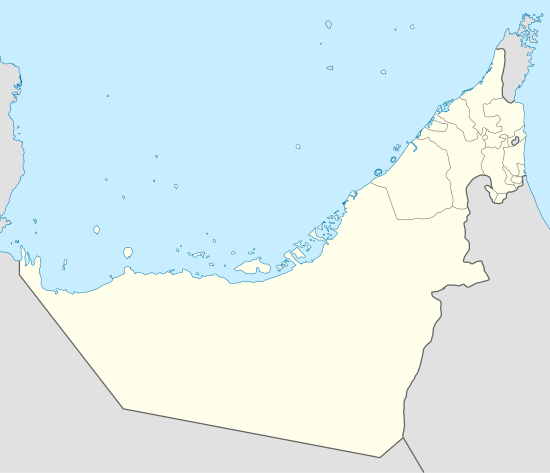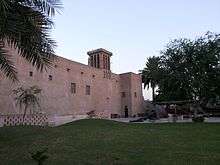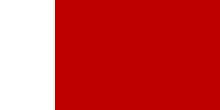Ajman
| Ajman عجمان | |||||
|---|---|---|---|---|---|
 Overview of Ajman | |||||
| |||||
 Ajman Location of Ajman in the UAE | |||||
| Coordinates: 25°24′49″N 55°26′44″E / 25.41361°N 55.44556°ECoordinates: 25°24′49″N 55°26′44″E / 25.41361°N 55.44556°E | |||||
| Country | United Arab Emirates | ||||
| Government | |||||
| • Type | Monarchy | ||||
| • Emir | Sheikh Humaid bin Rashid Al Nuaimi | ||||
| Population (2010) | |||||
| • Total | 238,000 | ||||
Ajman (Arabic: عجمان 'Aǧmān) is the capital of the emirate of Ajman in the United Arab Emirates, located along the Persian Gulf.
History
The foundation of Ajman under Nuami rule took place between 1803 and 1810, when Sheikh Rashid bin Humaid Al Nuami and his followers took the coastal settlement of Ajman from members of the Al Bu Shams tribe in a short conflict.[1] It wasn't until 1816 or 1817, however, that the Ajman fort finally fell to Rashid's followers and his rule was endorsed by the powerful Sheikh of neighbouring Sharjah and Ras Al Khaimah, Sheikh Sultan bin Saqr Al Qasimi.[2]
On 8 January 1820, following the sack of Ras Al Khaimah by a British force led by Sir W.G. Keir, Sultan bin Saqr signed the General Maritime Treaty with the United Kingdom on 4 February 1820, followed on 15 March by Rashid bin Humaid[3] at Falaya Fort.
An 1822 British maritime survey noted that Ajman had one of the best backwaters on the coast and was a small town with a single fortified building, the ruler's house. In common with many other coastal towns on what became the Trucial Coast, the population was mobile depending on the season – there were as many as 1,400 to 1,700 men of the 'Mahamee' tribe living there during the pearl hunting season (April–September), many of whom would migrate to Al Buraimi in the date season. The survey notes that Ajman's ruler Rashid bin Ahmed considered his dominion independent of Emirate of Sharjah, but that Sharjah did not maintain that view even though it had no power over Ajman.[4] The survey noted that the inhabitants of Ajman were 'mostly strict Wahhabis' and recorded the presence of the ruined village of Fasht down the shore from Ajman town, which is today the Fisht suburb of Sharjah city.

In 1831, the Sheikh of Ajman accepted a subsidy from the Imam of Muscat to join with Sultan bin Saqr of Sharjah against Sohar, but following Sultan's defeat declared for Sohar. In his absence, a part of Bani Yas from Abu Dhabi sacked Ajman town and its date groves.[5] In retaliation, the forces of Ajman committed 'daring depredations' upon the cities of Sohar and Muscat. When called upon to provide redress for the actions of his 'subject', Sultan bin Saqr disavowed any authority over Ajman and in 1832 a British naval force was sent to Ajman to obtain redress for the raids on the East Coast cities.[6] Ending a conflict between Sharjah, Ajman and Dubai on the one hand and Abu Dhabi on the other, Ajman (together with the other parties) signed the 1835 Maritime Treaty in its own right.[6]
In 1840, Humaid bin Obeid bin Subt of Al Heera invaded Ajman supported by a body of the Bani Naeem. Although initially reluctant to assist Humeid bin Rashid, Sultan bin Suggur of Sharjah sent his son Suggur who, together with Maktoum of Dubai, ejected the invaders and sacked Al Heera in reprisal. In 1843 a further Maritime Treaty was signed between the Trucial Sheikhs and the British and then, on 4 May 1853, 'A Perpetual Treaty of Peace' was entered into by the coastal Sheikhs, including Ajman. A copy of this treaty is on display in Ajman Museum. A further treaty of 1892 bound the Trucial States to Britain.
By the 20th Century, Lorimer's survey of the coast of the Trucial States showed Ajman to be a small town of some 750 inhabitants (in comparison, the population of Dubai at the time numbered over 10,000).[7]
On 2 December 1971, Ajman, under Sheikh Rashid bin Humayd Al Nuaimi, joined the United Arab Emirates.
Rulers
Its rulers were:
- 1810 – 1816 Sheikh Rashid bin Humaid Al Nuaimi
- 1816 – 1838 Sheikh Rashid bin Ahmed Al Nuaimi (d. 1838)
- 1838 – 1841 Sheikh Humaid bin Rashid Al Nuaimi (1st time) (d. 1873)
- 1841 – 1848 Sheikh `Abd al–`Aziz I ibn Rashid Al Nuaimi (d. 1848)
- 1848 – 1873 Sheikh Humaid II bin Rashid Al Nuaimi (2nd time)
- 1873 – April 1891 Sheikh Rashid bin Humaid Al Nuaimi (d. 1891)
- April 1891 – 8 July 1900 Sheikh Humaid bin Rashid Al Nuaimi (d. 1900)
- 8 July 1900 – February 1910 Sheikh Abdulaziz bin Humaid Al Nuaimi (b. 18.. – d. 1910)
- February 1910 – January 1928 Sheikh Humaid bin Abdulaziz Al Nuaimi
- January 1928 – 6 September 1981 Sheikh Rashid ibn Humaid Al Nuaimi (b. 1904 – d. 1981)
- 6 September 1981 – present Sheikh Humaid ibn Rashid Al Nuaimi (b. 1931)
Population
The city has more than 90% of the population of the emirate. The area runs directly into the city of Sharjah along the coast to the south-west, which in turn is adjacent to Dubai, forming a continuous urban area.
Commercial
Ajman is home to the Ruler's office, companies, commercial markets, and about 50 international and local retail shops. Banking interests include: Emirates National Bank of Dubai, Ajman Bank, Arab Bank PLC, Bank Saderat Iran, and Commercial Bank of Dubai. Ajman is also home to fishing industry & Seafood Importers/Exporters in UAE. Shopping malls include Ajman China Mall and City Centre Ajman.
Ajman Free Zone
With capacity to accommodate 1500 companies and serving over 1,000 vessels a year, Ajman Port and Ajman Free Zone are major contributors to the emirate's economy. Exporting to over 65 countries, the Free Zone's companies comprise something like 20% of the UAE's overall industrial units, with some 256 industrial companies operating from the zone.[8]
Tourism
Ajman is continuing the development stalled by the financial crisis of 2007–2008 and once again undergoing a period of growth. Tourist attractions in the emirate, including hotels, shopping and cultural destinations are growing rapidly. Tourist attractions include the Ajman National Museum situated at Ajman Fort, the Red Fort and the museum in the inland enclave of Manama.
Ajman's corniche is a popular evening and weekend destination for families and features a number of fast food outlets, coffee shops and stalls. It is home to the 'Outside Inn', a popular watering hole with expatriates, as well as to a number of hotels, including the Ramada, Ajman Palace, the Kempinski, the Ajman Saray and the Fairmont Ajman.
Transportation
The natural port (or khor) of Ajman is located along a natural creek which penetrates the town.[9] Ajman is also home to Arab Heavy Industries, one of the world's largest ship manufacturing firms.[10]
The main airport in the emirate is located in the enclave of Manama, about 60 km east of the city, thus in one of the farthest removed parts of the emirate. However, Sharjah International Airport is only a dozen kilometres away.
References
- ↑ Wilson, Graeme (2010). Rashid: Portrait of a Ruler. UK: Media Prima. p. 12. ISBN 9789948152880.
- ↑ Wilson, Graeme. Rashid, portrait of a ruler. London. p. 21. ISBN 9789948152880. OCLC 843954755.
- ↑ General Maritime Treaty, 1820
- ↑ Schofield, R (1990). Islands and Maritime Boundaries of the Gulf 1798–1960. UK: Archive Editions. p. 543. ISBN 9781852072759.
- ↑ Schofield, R (1990). Islands and Maritime Boundaries of the Gulf 1798–1960. UK: Archive Editions. p. 133. ISBN 9781852072759.
- 1 2 Schofield, R (1990). Islands and Maritime Boundaries of the Gulf 1798–1960. UK: Archive Editions. pp. 134–135. ISBN 9781852072759.
- ↑ Lorimer, John G (1908). Gazetteer of the Persian Gulf Oman & Central Arabia. Bombay: Government of India. pp. 1433–1451.
- ↑ "Ajman Free Zone". UAEFreeZones.com. Retrieved 30 November 2014.
- ↑ Ajman Free Zone Archived April 18, 2008, at the Wayback Machine.
- ↑ "Ajman travel guide". www.world66.com. Archived from the original on 2010-01-24. Retrieved 31 July 2016.


